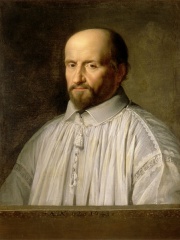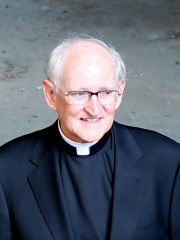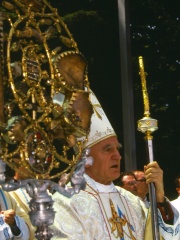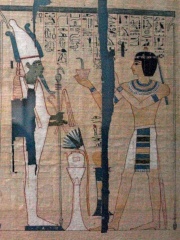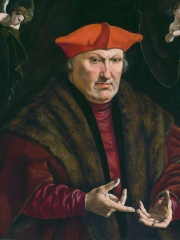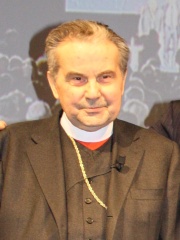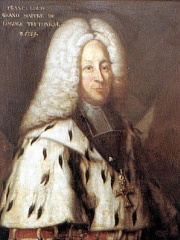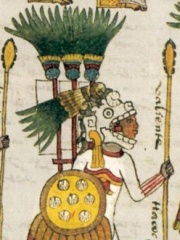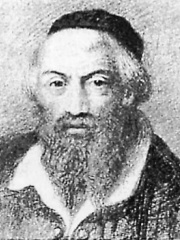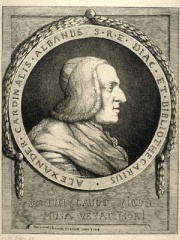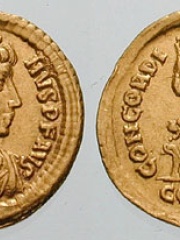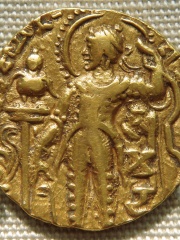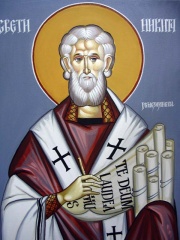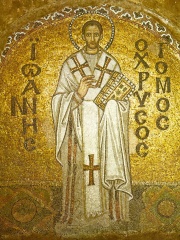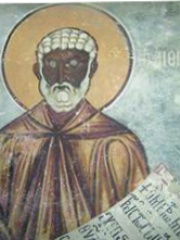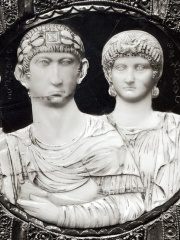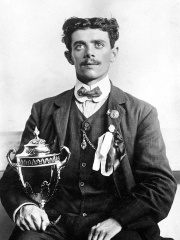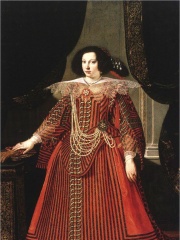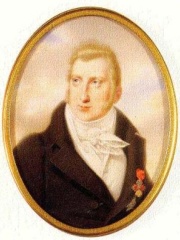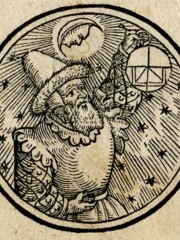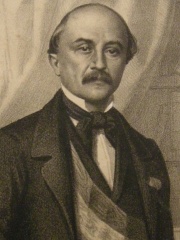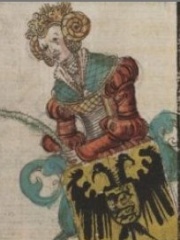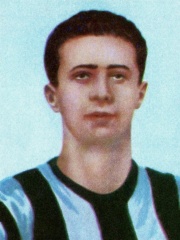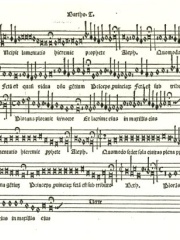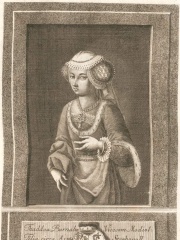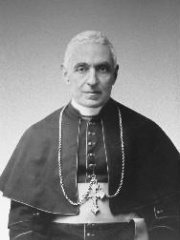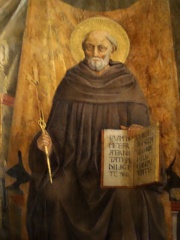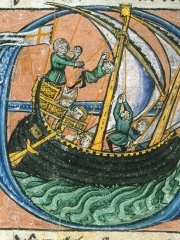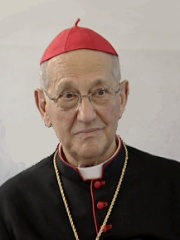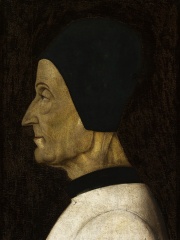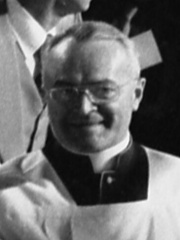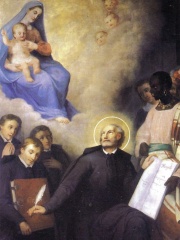Religious Figure
Chromatius
335 - 407
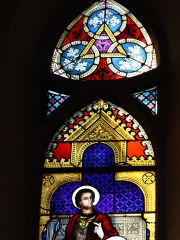
 Chromatius
Chromatius
Chromatius (died c. 406/407 AD) was a bishop of Aquileia. He was probably born at Aquileia, and grew up there. His father died when Chromatius was an infant. Read more on Wikipedia
His biography is available in 20 different languages on Wikipedia (up from 19 in 2024). Chromatius is the 1,934th most popular religious figure (down from 1,872nd in 2024), the 2,538th most popular biography from Italy (up from 2,672nd in 2019) and the 446th most popular Italian Religious Figure.
Memorability Metrics
Page views of Chromatius by language
Among Religious Figures
Among religious figures, Chromatius ranks 1,934 out of 3,187. Before him are Jean du Vergier de Hauranne, Constantine, Laurean Rugambwa, James Michael Harvey, Franjo Kuharić, and Pinedjem II. After him are Érard de la Marck, Carlo Caffarra, Count Palatine Francis Louis of Neuburg, Tlacaelel, Moses Isserles, and Alessandro Albani.
Most Popular Religious Figures in Wikipedia
Go to all RankingsJean du Vergier de Hauranne
1581 - 1643
HPI: 61.13
Rank: 1,928
Constantine
411 - 443
HPI: 61.13
Rank: 1,929
Laurean Rugambwa
1912 - 1997
HPI: 61.12
Rank: 1,930
James Michael Harvey
1949 - Present
HPI: 61.11
Rank: 1,931
Franjo Kuharić
1919 - 2002
HPI: 61.11
Rank: 1,932
Pinedjem II
1100 BC - 969 BC
HPI: 61.11
Rank: 1,933
Chromatius
335 - 407
HPI: 61.10
Rank: 1,934
Érard de la Marck
1472 - 1538
HPI: 61.10
Rank: 1,935
Carlo Caffarra
1938 - 2017
HPI: 61.09
Rank: 1,936
Count Palatine Francis Louis of Neuburg
1664 - 1732
HPI: 61.07
Rank: 1,937
Tlacaelel
1397 - 1487
HPI: 61.07
Rank: 1,938
Moses Isserles
1520 - 1572
HPI: 61.07
Rank: 1,939
Alessandro Albani
1692 - 1779
HPI: 61.07
Rank: 1,940
Contemporaries
Among people born in 335, Chromatius ranks 8. Before him are Magnus Maximus, Theon of Alexandria, Samudragupta, Nicetas of Remesiana, Rufinus, and Eunomius of Cyzicus. Among people deceased in 407, Chromatius ranks 4. Before him are John Chrysostom, Moses the Black, and Gjúki. After him are Maria, Gratian, and Marcus.
Others Born in 335
Go to all RankingsMagnus Maximus
POLITICIAN
335 - 388
HPI: 74.65
Rank: 2
Theon of Alexandria
MATHEMATICIAN
335 - 405
HPI: 70.00
Rank: 3
Samudragupta
POLITICIAN
335 - 380
HPI: 69.46
Rank: 4
Nicetas of Remesiana
RELIGIOUS FIGURE
335 - 414
HPI: 64.84
Rank: 5
Rufinus
POLITICIAN
335 - 395
HPI: 63.38
Rank: 6
Eunomius of Cyzicus
RELIGIOUS FIGURE
335 - 394
HPI: 63.01
Rank: 7
Chromatius
RELIGIOUS FIGURE
335 - 407
HPI: 61.10
Rank: 8
Others Deceased in 407
Go to all RankingsJohn Chrysostom
RELIGIOUS FIGURE
349 - 407
HPI: 81.25
Rank: 1
Moses the Black
RELIGIOUS FIGURE
332 - 407
HPI: 73.05
Rank: 2
Gjúki
POLITICIAN
400 - 407
HPI: 62.87
Rank: 3
Chromatius
RELIGIOUS FIGURE
335 - 407
HPI: 61.10
Rank: 4
Maria
POLITICIAN
385 - 407
HPI: 59.18
Rank: 5
Gratian
POLITICIAN
400 - 407
HPI: 59.07
Rank: 6
Marcus
POLITICIAN
400 - 407
HPI: 58.63
Rank: 7
In Italy
Among people born in Italy, Chromatius ranks 2,538 out of 5,161. Before him are Dorando Pietri (1885), Maria Caterina Farnese (1615), Leopold, Prince of Salerno (1790), Campanus of Novara (1210), Luigi Carlo Farini (1812), and Margaret of Sicily (1237). After him are Ugo Locatelli (1916), Carlo Caffarra (1938), Adriano Panatta (1950), Bartolomeo Tromboncino (1470), Sergio Bertoni (1915), and Taddea Visconti (1351).
Others born in Italy
Go to all RankingsDorando Pietri
ATHLETE
1885 - 1942
HPI: 61.15
Rank: 2,532
Maria Caterina Farnese
POLITICIAN
1615 - 1646
HPI: 61.14
Rank: 2,533
Leopold, Prince of Salerno
POLITICIAN
1790 - 1851
HPI: 61.14
Rank: 2,534
Campanus of Novara
MATHEMATICIAN
1210 - 1296
HPI: 61.13
Rank: 2,535
Luigi Carlo Farini
PHYSICIAN
1812 - 1866
HPI: 61.11
Rank: 2,536
Margaret of Sicily
NOBLEMAN
1237 - 1270
HPI: 61.11
Rank: 2,537
Chromatius
RELIGIOUS FIGURE
335 - 407
HPI: 61.10
Rank: 2,538
Ugo Locatelli
SOCCER PLAYER
1916 - 1993
HPI: 61.09
Rank: 2,539
Carlo Caffarra
RELIGIOUS FIGURE
1938 - 2017
HPI: 61.09
Rank: 2,540
Adriano Panatta
TENNIS PLAYER
1950 - Present
HPI: 61.08
Rank: 2,541
Bartolomeo Tromboncino
COMPOSER
1470 - 1535
HPI: 61.07
Rank: 2,542
Sergio Bertoni
COACH
1915 - 1995
HPI: 61.07
Rank: 2,543
Taddea Visconti
NOBLEMAN
1351 - 1381
HPI: 61.07
Rank: 2,544
Among Religious Figures In Italy
Among religious figures born in Italy, Chromatius ranks 446. Before him are Giovanni Battista Scalabrini (1839), John Gualbert (995), Antonio Bacci (1885), Dagobert of Pisa (1100), Crescenzio Sepe (1943), and Sergio Sebastiani (1931). After him are Carlo Caffarra (1938), Alessandro Albani (1692), Lawrence Justinian (1381), Corrado Bafile (1903), Virgilio Noè (1922), and John Leonardi (1541).
Giovanni Battista Scalabrini
1839 - 1905
HPI: 61.31
Rank: 440
John Gualbert
995 - 1073
HPI: 61.30
Rank: 441
Antonio Bacci
1885 - 1971
HPI: 61.24
Rank: 442
Dagobert of Pisa
1100 - 1107
HPI: 61.22
Rank: 443
Crescenzio Sepe
1943 - Present
HPI: 61.22
Rank: 444
Sergio Sebastiani
1931 - 2024
HPI: 61.18
Rank: 445
Chromatius
335 - 407
HPI: 61.10
Rank: 446
Carlo Caffarra
1938 - 2017
HPI: 61.09
Rank: 447
Alessandro Albani
1692 - 1779
HPI: 61.07
Rank: 448
Lawrence Justinian
1381 - 1456
HPI: 61.00
Rank: 449
Corrado Bafile
1903 - 2005
HPI: 60.93
Rank: 450
Virgilio Noè
1922 - 2011
HPI: 60.88
Rank: 451
John Leonardi
1541 - 1609
HPI: 60.86
Rank: 452
